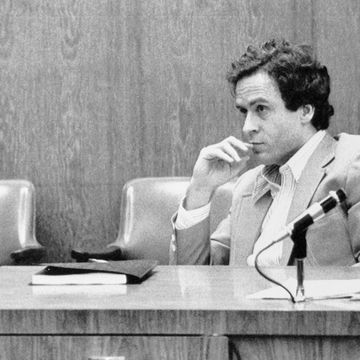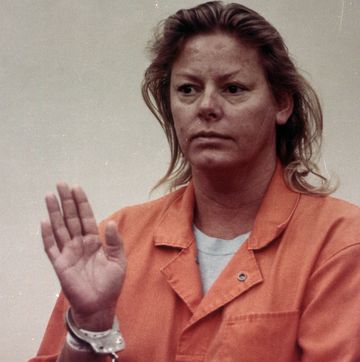Here’s what you’ll learn when you read this article:
- Ted Bundy, while on Florida’s death row in the early 1980s, offered to help authorities profile the Green River Killer, later identified as Gary Ridgway.
- Dave Reichert, the lead investigator, flew to Florida to interview Bundy, who provided insights into the mindset of a serial killer.
- Bundy and Ridgway shared many similarities, including both men growing up in Washington.
In 1982, a series of mysterious murders began plaguing Washington state’s King County. As more young women disappeared, only for their remains to turn up along the Green River, investigators raced to catch the cold-blooded menace responsible.
But with no obvious leads, they turned to an unlikely source for help: Ted Bundy, the prolific serial killer responsible for at least 36 murders and, one criminologist believes, possibly as many as 100.
The new Hulu documentary Ted Bundy: Dialogue with the Devil, premiering Thursday, explores how Bundy’s chilling, yet valuable insight assisted police in identifying and apprehending Gary Ridgway as the notorious “Green River Killer.”
As detectives discovered, Bundy and Ridgway shared many eerie similarities, among them their Northwestern origins and their sinister methods. And, like Bundy, the full scale of Ridgway’s terror still remains a mystery.
Bundy and Ridgway both had Washington upbringings
Born in November 1946 in Burlington, Vermont, Bundy moved to Tacoma, Washington, as a child. While growing up in the area, he showed a fascination with knives at age 3 and an obsession with spying and stealing as a teen. Academics came easier to Bundy than social graces, and he graduated with a psychology degree from the University of Washington in 1972.
Around 1974, women in the Washington and Oregon area started going missing. The word on the street was that they would be lured into a car by a man named Ted, who pretended to be injured with his arm in a sling and in need of help. That fall, Bundy moved to Utah for law school, and women there started to disappear, too. The serial killer continued to strike wherever he went and managed to escape custody twice before his final capture in Florida in February 1978.
Like Bundy, Gary Ridgway wasn’t originally from Washington. The future Green River Killer was born in Utah in February 1949 then raised in Washington state near Seattle’s SeaTac airport. Before graduating high school, he joined the Navy and was sent to Vietnam.
When he returned, Ridgway started painting trucks. He was steadily employed for decades, but around 1982, his murderous tendencies emerged. Runaways and sex workers started disappearing off of State Route 99 in Washington’s King County.
New research suggests the geographic proximity of Bundy and Ridgway might have been more than just coincidence. Author Caroline Fraser hypothesizes in her 2025 book Murderland: Crime and Bloodlust in the Time of Serial Killers that lead and arsenic pollution might have played a role in the emergence of violent criminals in the Pacific Northwest.
In any case, there was a new killer on the loose and authorities were desperate for clues.
Bundy offered his assistance from death row
By 1986, a detective named Dave Reichert had been working on the Green River case for years. Even with 40 female victims involved and Ridgway on the suspect list, the King County sheriff didn’t have any reliable leads when he got a fascinating offer to help.
Bundy had been reading about the Green River Killer and saw Reichert’s photo in stories, according to The New York Times. “Don’t ask me why I believe I’m an expert in this area, just accept that I am and we’ll start from there,” Bundy wrote to Reichert from a Florida jail.
At the time, Bundy had been imprisoned in Florida for six years and was awaiting his execution. Reichert flew to visit the notorious murderer with fellow investigator Robert Keppel, who was an investigator on Bundy’s case. According to Keppel’s book, The Riverman: Ted Bundy and I Hunt for the Green River Killer, Reichert said he was the only one the convicted killer would talk to.
At some point, Bundy suggested to Reichert that the Green River Killer—whom he called “Riverman”—might be going back to the sites he left the bodies and performing sexual acts and suggested that the detectives stake out fresh burial sites. It was later determined that Ridgway tended to bring victims to his home, strangle them, and dispose of their bodies in the woods. That’s how several ended washing up along the nearby Green River.
Investigators felt both killers had “no remorse”
The information that Bundy provided helped the investigators get inside the mind of a murderer—especially one who knew the Washington area well—and eventually they did identify Ridgway as the Green River Killer by matching his DNA to samples collected from his victims. He was arrested in November 2001, more than 12 years after Bundy was executed.
For Reichert, the parallels between Bundy and Ridgway were immediately clear. As journalist Sarah Kershaw reported for The New York Times:
“The sheriff, who spent three days interviewing Mr. Ridgway alone, said he quickly realized that serial killers have a lot in common, whether they kill prostitutes, as Mr. Ridgway and Jack the Ripper did, young boys, as John Wayne Gacy did, or young women, as Mr. Bundy did. Both Mr. Bundy... and Mr. Ridgway were sexual predators who killed during or after sexually assaulting or having sex with their victims.”
Beyond that, both serial killers had the same mindset. “First off, there’s no remorse,” Reichert told The New York Times. “He doesn’t have any feelings toward anybody, his family included. And that’s what I saw in Bundy and what I saw in Ridgway.”
Reichert also said that Bundy would tell him actions he expected Ridgway to do, but in reality, they were veiled confessions of things Bundy had already performed. “It was as if Mr. Bundy was jealous of the attention the Green River killer was getting,” Reichert hypothesized.
Both killers were proud of their actions. As the Times continued: “Like Mr. Bundy, Sheriff Reichert said, Mr. Ridgway craved attention and control and was prideful when discussing his killings. When detectives presented him with an unsolved murder to see if he would confess it, he told them: ‘Why, if it isn’t mine? Because I have pride in, in, what I do. I don’t wanna take it from anybody else.’”
Ridgway’s victims are still being identified
Ridgway pleaded guilty to 48 counts of aggravated first-degree murder as part of a bargain with prosecutors in 2003 and was sentenced to 48 consecutive life sentences without parole. At the time, he was considered the most prolific serial killer in U.S. history, though the FBI later granted that dishonor to Samuel Little, who has more than 60 confirmed victims.
“I’m sorry for causing so much pain for so many people,” Ridgway said at his sentencing. Although he’s officially responsible for 49 murders, Ridgway claimed in 2013 the true number is actually “75 to 80.”
Police have continued to identify victims of Ridgway. In December 2023, DNA testing identified a set of long-anonymous remains as 15-year-old Lori Anne Razpotnik, who disappeared near Seattle in 1982.
In September 2024, Ridgway was temporarily transferred to a different prison because he offered to help find the remains of additional victims in King County, according to court documents. Investigators have only said the involved cases “remain open.”
The full extent of Ridgway’s carnage might never be known. But, thanks in large part to Bundy’s insights, more of the truth might continue to emerge.
Tyler Piccotti joined the Biography.com staff as an Associate News Editor and is now the News and Culture Editor. He previously worked as a reporter and copy editor for a daily newspaper recognized by the Associated Press Sports Editors. In his current role, he shares the true stories behind your favorite movies and TV shows and profiles rising musicians, actors, and athletes. When he's not working, you can find him at the nearest amusement park or movie theater and cheering on his favorite teams.















